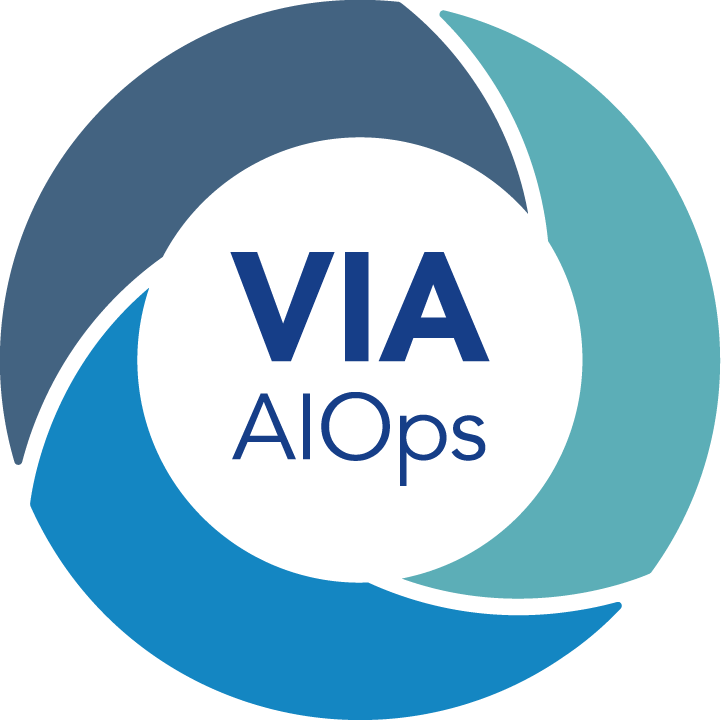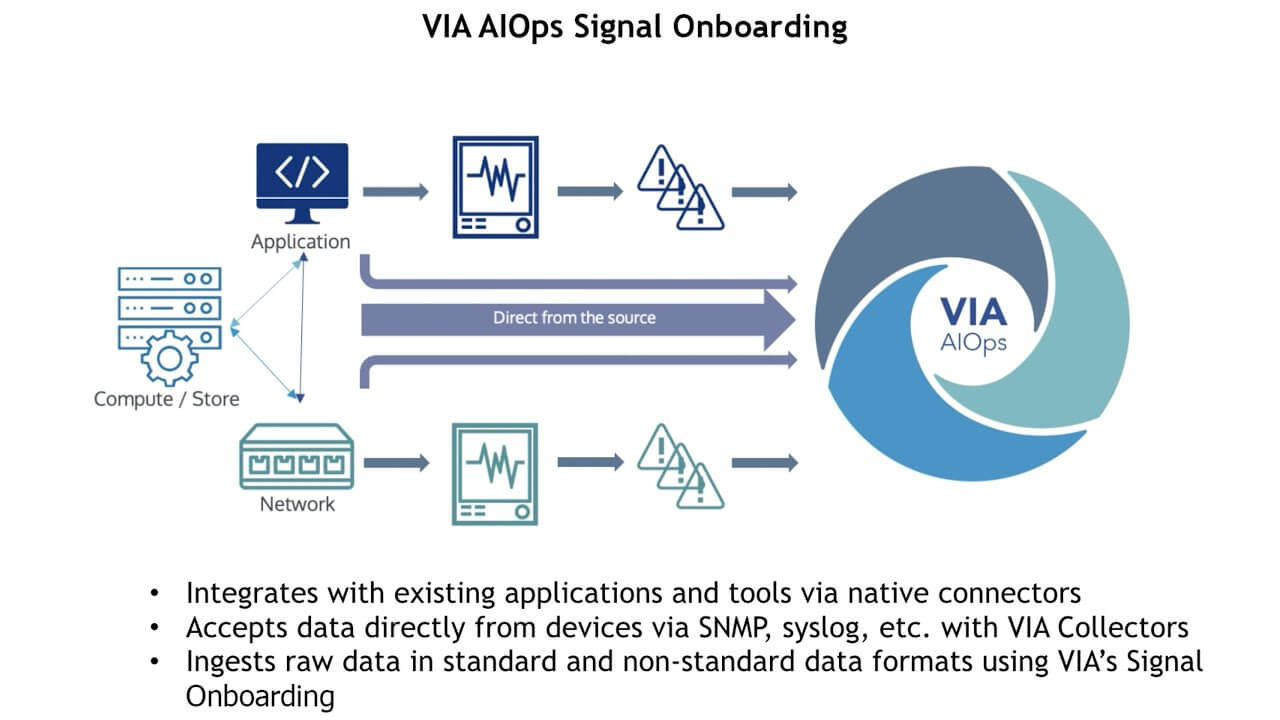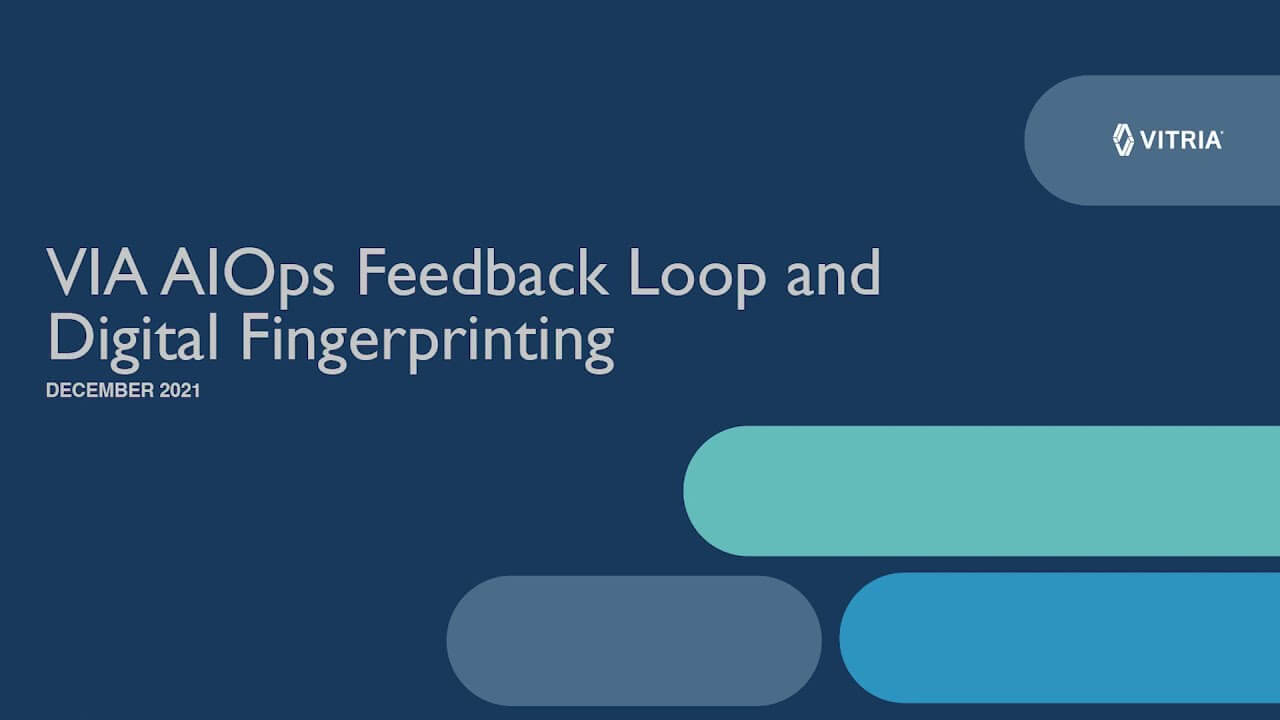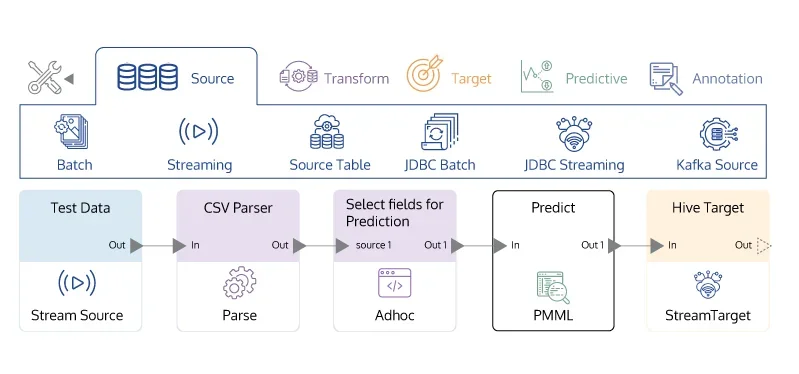VIA’s Key Differentiating Capabilities
Full Ecosystem Observability
Any vendor, protocol, tool across all technology layers.
Massive scale capability across the technology stack, applications, and service domains in real time.
Real time analytics, AI, and ML deployed in ingestion, enrichment, and correlation of metrics, events, logs, and traces to detect anomalies, discover root cause across layers.
Intelligent Automation & AI with Knowledge
AI-generated incident analysis and probable cause determination.
AI-base automation of service recovery actions to remediate or mitigate incidents.
Automation orchestrated across related systems.
Shared knowledge across AI agents in the AIOps process from ingestion through recommended fix improving accuracy and accelerating journey to self-healing.
Rapid Deployment
Ingests Metrics, Events, Logs, Traces across all service layers from any source.
Leverages existing monitoring tools.
Enriches and “contextualizes” the data.
Open Standards and Integrations.
Learn by doing with measurable ROI in each 90 to 120 day project.

Fast Time-to-Value with Measurable Results
Quantifiable ROI achieved in less than 60 days.
Measurable, high payback results with a platform that is easy to install, integrate, manage, configure, and use.
Transformation You’ll Never Outgrow
Scalability required for centralizing data monitoring and cross-correlating data from the entire service delivery ecosystem.
Proven in internet-scale networks with 50+ million devices, billions of events per day, thousands of distinct data streams.
Functionality that drives VIA’s differentiation includes:
- Automatic generation of baselines for every metric and dimension combination using unsupervised machine learning
- Continuous machine-learned topology eliminates dependency on hard-to-maintain network topology information
- Stochastic modeling to effectively reduce noise and accelerate fault detection
- Affinity analysis to group signals within and across service layers
- Correlating issues directly to customers’ experience and leveraging predictive analytics to prioritize actions based on impact
- Bidirectional communication with service management systems to fully support automation objectives

Fault and Performance Management in a single application
Managing service assurance independently within each service layer constraints, operational productivity, and the service assurance process. Teams are often chasing symptoms within their silo when the root cause of the problem lies outside their visibility and control. Multiple operations support teams may be addressing the same or different symptoms but all of them are attributable to the same root cause. Addressing these service issues is slow and extremely labor-intensive.
VIA AIOps delivers the information required to manage faults and performance across the service delivery stack in one application with a single incident inbox.

This short video demonstrates how VIA serves up incidents with all the relevant information required by the operations team to act. Fault and performance management uses a single pane of glass with explanatory AI provided to drill down into the details as required.
Baselines
VIA AIOps automatically determines the correct algorithm to use on streaming data to generate baselines. Unsupervised machine learning generates baselines for every metric and dimension combination.
Baselines are created as data is ingested and continuously updated and improved over time with more data. The use of machine-learned baselines versus simple thresholds allows VIA to reduce noise and detect anomalous behavior occurring during both low usage and peak periods.
Baselines more accurately detect faults and performance issues. VIA AIOps delivers a 4X reduction in signals requiring actions as compared to competitive solutions.

This short video demonstrates how VIA serves up incidents with all the relevant information required by the operations team to act. Fault and performance management uses a single pane of glass with explanatory AI provided to drill down into the details as required.
Rapid implementation:
VIA delivers 99% alarm noise reduction on day one
With only a handful of out-of-the-box AI algorithms, you quickly gain the advantages of VIA’s deduplication, alarm noise reduction, and incident prioritization for all hosts, entities, or services in your operating environment. Artificial Intelligence and machine learning embedded within VIA’s out-of-the-box AI algorithms are explainable, extensible, and easy to use.

Extensibility
VIA AIOps delivers the extensibility needed to adopt to business change and the addition of new services
Built for horizontal scaling, VIA AIOps reliably supports mission-critical operations that require massive data capabilities.
VIA simplifies the process of data ingestion through Signal Onboarding, a GUI-driven toolset that:
- analyzes sample data
- auto-generates a real-time parser
- models the data for real-time analysis.
Never-before-seen data feeds can be ingested in less than an hour without the need to write code. Data does not need to fit a specific data model or specifications, eliminating the development of thousands of lines of code to ingest and parse data sets. The user can onboard data from off-the-shelf and home-grown tools, new SNMP traps, bulkstats, Syslog, and other data sets in the field without any coding or feature requests.

The Signal Onboarding video takes you through each step of the data onboarding process and how quickly VIA builds data models without the need to write code.
VIA builds the trust and confidence to continue to develop remediation automation
VIA is based on an explainable UI and the users’ ability to adopt VIA to their operational best practices. This clear-box approach builds trust and instills confidence in operations teams to use analytics to further process automation.
VIA’s feedback loop combines human and artificial intelligence to continuously improve the accuracy of AI algorithms and support the enablement of automated actions. VIA provides information on each incident it discovers including the probable root cause, key symptoms, impacted populations, duration, and severity.
Users can provide feedback and provide context. The system uses this information for relevance ranking and training the algorithm for greater accuracy. In addition, this information over time can be used to determine if automated action should be implemented based on the consistency of the response needed to respond to the incident.

Digital fingerprinting accelerates decision-making on the next actions to take to address incidents. Engineers can review the actions taken on similar incidents and determine if they should take the same action. Combining human and artificial intelligence accelerates response and drives improved operational performance.
Custom dashboards can be created in minutes for every persona
To further maximize operational productivity, dashboards can be created for all users, from executives who need a high-level view of service performance to the service reliability engineers who need to act on the identified service performance issues.
VIA delivers explanatory AI, visual and text-based explanations of all analyses and actions. Users can drill into why a detection occurred, why a baseline was generated the way that it was, why signals were correlated, and why a root cause was identified.

This video demonstrates how easily custom dashboards can be created.
VIA AIOps: Transforming Incident Management




A new incident management operating model and a new way of working through AI process automation
Proven ROI with cost reduction, better customers’ experiences, and a leaner, more efficient, and effective IT operational staff.
VIA AI Platform Operationalizes at Massive Scale
Low-code, Graphic Development Environment

- Compose “AI Data Flows” (“ADFs”) easily
- Utilize a wide variety of automation built into platform
- Deployed as “Apps” on the highly scalable Vitria AI Platform
- Security, resiliency, and automation built into platform
Enabling rapid innovation of features and use cases

VIA AI: a Scalable Runtime Platform
- Coordinates the deployment and execution of hundreds of “Vitria AI Flows”
- Supports elastic-scalability, high availability, and blue-green deployments
- Utilizing best of breed open-source technologies for scaling real-time AI and streaming Analytics
- On and off Premise data centers.






